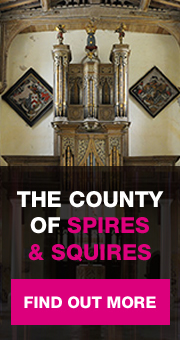A Royal church with yet further royal associations: a very significant victim of the Dissolution of the Monasteries.
The village, Manor, and church had been royal property since the Conquest when it was granted to William I‘s niece. By a circuitous route it descended in 1337 to Edmund, Duke of York, the fifth son of Edward lll. From then it developed into the religious headquarters of the Yorkist faction – with a collegiate church founded here in 1415 which in turn became the principal burial site of the family – Edmund’s son who died at Agincourt, Edmund, 2nd Duke of York and his nephew Richard, 3rd Duke.
The great nave of this Yorkist church survives with it’s beautiful well proportioned fenestration and flying buttresses. The two royal monuments, the only ones in the county, are to be found on either side of the main altar. Whilst the village is indelibly linked to the fate of Mary, Queen of Scots, they have nothing to do with her.
She was buried here after her execution in 1587 but shortly afterwards transferred in great secrecy to Peterborough Cathedral and finally to Westminster Abbey to be installed in a great tomb erected by her son James I to vie with that of Queen Elizabeth.
But royal these tombs are and, strangely enough, they also belong to the reign of Elizabeth I. Looking at them one is struck by the lack of any inscription – no name, no date, no eulogy. Also the design is very odd: more architecture than monument. They seem to owe their form to contemporary fireplace or porch designs (think of those locally at Kirby Hall and Deene).
The only clue to the identity of those buried here are the large coats of arms that dominate the central portion. On the tomb to the left the royal arms with a bar coupled with those of the powerful house of Nevile. On the right simply the barred royal arms of Plantagenet. Above both have a crest, the fetlocked falcon and both show ducal coronets. Disentangling these clues leads to the identity of those buried here. But this is no shrine to the Plantagenet dynasty, rather a sober and correct memorial to members of an earlier royal family, ie not Tudor but one connected to Queen Elizabeth through her grandmother and namesake Elizabeth of York, wife of Henry VII.
These tombs were raised by Elizabeth to replace the original monuments that had stood by the high altar to the founders of this church before being desecrated by the Duke of Northumberland. Elements of the original brasses and slabs can be seen at their bases. To the right is the tomb of Edward, 2nd Duke of York, to the left is that of his nephew Richard, 3rd Duke of York and his wife, Lady Cecily Neville. Edward, 2nd Duke of York, (circa 1373-1415) was the eldest son of Edmund de Langley, 1st Duke of York, and grandson of Edward III and Queen Isabella. During the reign of his cousin, Richard II, he held, amongst other appointments, the Admiralty of the Northern Fleet, Constable of the Tower of London, Warden of the Cinque Ports. He continued to support Richard until he was deposited by Bolingbroke. Not surprisingly he, Henry IV, kept at some distance from him but within two years the Duke was confirmed in his title and lands and served in much the same capacity. Under Henry V he was often in France and it was here that he died at the Battle of Agincourt when commanding the right flank of the English army. He was brought back to his seat at Fotheringhay for burial. Having no children his title and possessions passed to his infant nephew, Richard.
Richard, 3rd Duke of York (1411-1460) was the son of Edward’s younger brother, Richard, Earl of Cambridge and his wife Lady Anne Mortimer. Through his parents, he was doubly descended from Edward III. Through inheritance from both sides of the family he became one of the richest nobles in England (which enabled him to complete his father’s work at Fotheringhay). He became the head of the House of York in its struggles with that of Lancaster. The tale of the Wars of the Roses is well known, not least through Shakespeare.
Richard was reluctant to openly disobey Henry VI but court politics and his own inability to influence matters due to his appointments in Ireland eventually led to his unauthorised return, the first Battle of St Albans, 1455, the virtual imprisonment of Henry VI and Queen Margaret, York’s claiming the throne in 1460 and his own death at the Battle of Wakefield at the end of that year. York had married Cecily Neville, the sister of the Earl of Salisbury. They had four sons and three daughters of which two became in turn Kings of England as Edward IV and Richard III. Their middle brother Edmund having been killed with his father at Wakefield. Their third son, George, is the famous Duke of Clarence who died in a butt of Malmsey.
The tombs erected by Elizabeth to her great great grandfather and his uncle are probably by Thomas Thorpe of nearby Kingscliffe. He was part of a family of master masons and designers. His better known son, John, joined the Office of Works circa 1583 and continued there working at Richmond, Greenwich and Whitehall until 1601.
Please refer to the Glossary for any terms in the text that you are unfamiliar with.







